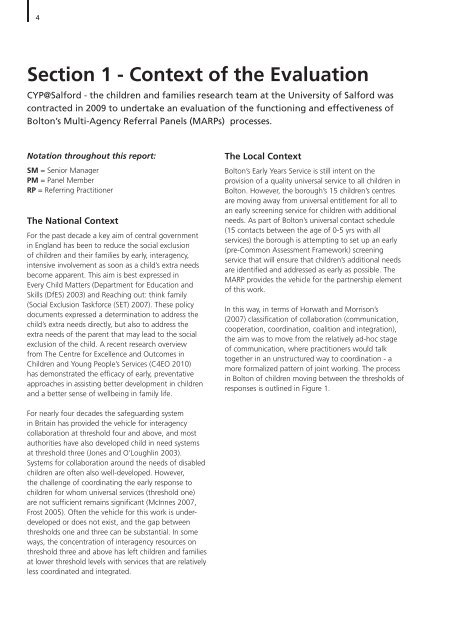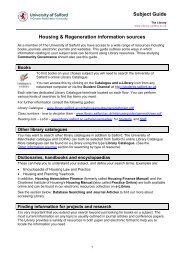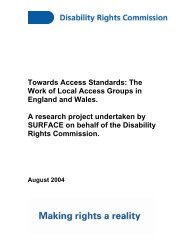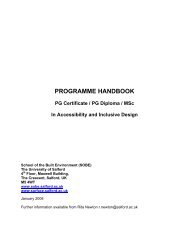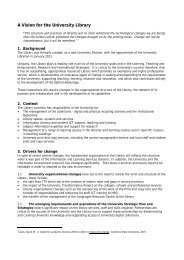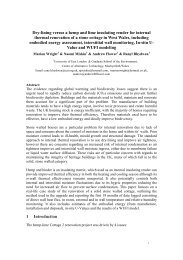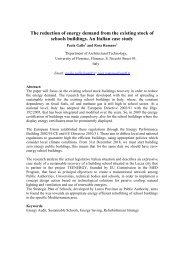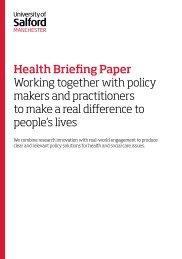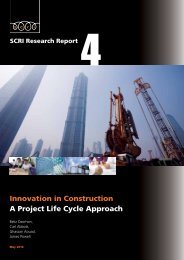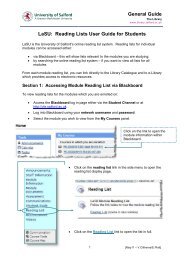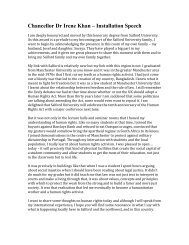FINAL REPORT - University of Salford
FINAL REPORT - University of Salford
FINAL REPORT - University of Salford
Create successful ePaper yourself
Turn your PDF publications into a flip-book with our unique Google optimized e-Paper software.
4<br />
Section 1 - Context <strong>of</strong> the Evaluation<br />
CYP@<strong>Salford</strong> - the children and families research team at the <strong>University</strong> <strong>of</strong> <strong>Salford</strong> was<br />
contracted in 2009 to undertake an evaluation <strong>of</strong> the functioning and effectiveness <strong>of</strong><br />
Bolton’s Multi-Agency Referral Panels (MARPs) processes.<br />
Notation throughout this report:<br />
SM = Senior Manager<br />
PM = Panel Member<br />
RP = Referring Practitioner<br />
The National Context<br />
For the past decade a key aim <strong>of</strong> central government<br />
in England has been to reduce the social exclusion<br />
<strong>of</strong> children and their families by early, interagency,<br />
intensive involvement as soon as a child’s extra needs<br />
become apparent. This aim is best expressed in<br />
Every Child Matters (Department for Education and<br />
Skills (DfES) 2003) and Reaching out: think family<br />
(Social Exclusion Taskforce (SET) 2007). These policy<br />
documents expressed a determination to address the<br />
child’s extra needs directly, but also to address the<br />
extra needs <strong>of</strong> the parent that may lead to the social<br />
exclusion <strong>of</strong> the child. A recent research overview<br />
from The Centre for Excellence and Outcomes in<br />
Children and Young People’s Services (C4EO 2010)<br />
has demonstrated the efficacy <strong>of</strong> early, preventative<br />
approaches in assisting better development in children<br />
and a better sense <strong>of</strong> wellbeing in family life.<br />
The Local Context<br />
Bolton’s Early Years Service is still intent on the<br />
provision <strong>of</strong> a quality universal service to all children in<br />
Bolton. However, the borough’s 15 children’s centres<br />
are moving away from universal entitlement for all to<br />
an early screening service for children with additional<br />
needs. As part <strong>of</strong> Bolton’s universal contact schedule<br />
(15 contacts between the age <strong>of</strong> 0-5 yrs with all<br />
services) the borough is attempting to set up an early<br />
(pre-Common Assessment Framework) screening<br />
service that will ensure that children’s additional needs<br />
are identified and addressed as early as possible. The<br />
MARP provides the vehicle for the partnership element<br />
<strong>of</strong> this work.<br />
In this way, in terms <strong>of</strong> Horwath and Morrison’s<br />
(2007) classification <strong>of</strong> collaboration (communication,<br />
cooperation, coordination, coalition and integration),<br />
the aim was to move from the relatively ad-hoc stage<br />
<strong>of</strong> communication, where practitioners would talk<br />
together in an unstructured way to coordination - a<br />
more formalized pattern <strong>of</strong> joint working. The process<br />
in Bolton <strong>of</strong> children moving between the thresholds <strong>of</strong><br />
responses is outlined in Figure 1.<br />
For nearly four decades the safeguarding system<br />
in Britain has provided the vehicle for interagency<br />
collaboration at threshold four and above, and most<br />
authorities have also developed child in need systems<br />
at threshold three (Jones and O’Loughlin 2003).<br />
Systems for collaboration around the needs <strong>of</strong> disabled<br />
children are <strong>of</strong>ten also well-developed. However,<br />
the challenge <strong>of</strong> coordinating the early response to<br />
children for whom universal services (threshold one)<br />
are not sufficient remains significant (McInnes 2007,<br />
Frost 2005). Often the vehicle for this work is underdeveloped<br />
or does not exist, and the gap between<br />
thresholds one and three can be substantial. In some<br />
ways, the concentration <strong>of</strong> interagency resources on<br />
threshold three and above has left children and families<br />
at lower threshold levels with services that are relatively<br />
less coordinated and integrated.


